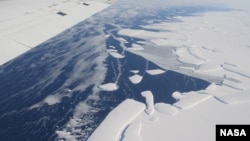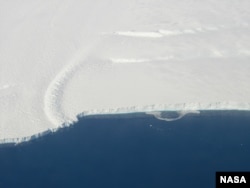Summer ice loss in parts of Antarctica is at its highest in 1,000 years, according to a new study which finds that the melt is coming largely from underneath ice shelves, the floating edges of the ice sheet that extend over the ocean.
The study is the first comprehensive survey of all the Antarctic ice shelves, which are the 1.5 million square kilometers that fringe much of the frozen continent.
Lead author Eric Rignot, a professor at the University of California, Irvine, says ice melt from below accounted for 55 percent of the shelf loss from 2003 to 2008, a rate much higher than previously thought.
“We find that the melting of the underside of the ice shelves is even larger than the production of icebergs," Rignot said. "So it is the dominant process of ice removal in the Antarctic.”
Rignot and colleagues used satellite observations, radar and computer models to measure features above the ice to calculate what was going on below.
“That includes the velocity of the ice, the thickness of the ice, how fast the freeboard [height of ice above sea level] of the ice shelf is changing with time and also how much snowfall there is on the top of the ice shelves,” Rignot said.
The measurements showed regional differences around the continent. The giant ice shelves - Ross, Filchner and Ronne - make up two-thirds of Antarctica’s ice shelves, yet accounted for only 15 percent of the melting.
Meanwhile, a dozen small ice shelves, which sit on relatively warmer water, produced half the total water from ice melt during the same period.
“That means that in a regime of climate warming where the properties of the Southern Ocean are changing, they may be changing faster than other oceans in the world," Rignot said. "We may be in a situation where the coastline of Antarctica may be changing at a faster pace than we thought in the past.”
The ocean is a very sensitive system, according to Rignot, and even small shifts, like changes in ocean circulation driven by wind, can make a huge difference in ice shelf melt.
“If the wind regime changes in the Southern Ocean, it is going to change the way the ocean heat is distributed on the coast, and that’s going to affect glaciers,” he said.
Sixty percent of the planet’s fresh water is locked in the massive Antarctic ice sheet. Rignot says the study will help scientists predict how the continent responds to a warmer ocean and contributes to global sea level rise.
“I think that it places more emphasis on the enormous importance of ice-ocean interaction in the Antarctic," he said. "If we really want to understand how these ice shelves evolve and will evolve in the future we must understand how the ocean is contributing to their melting in the underside.”
The study is the first comprehensive survey of all the Antarctic ice shelves, which are the 1.5 million square kilometers that fringe much of the frozen continent.
Lead author Eric Rignot, a professor at the University of California, Irvine, says ice melt from below accounted for 55 percent of the shelf loss from 2003 to 2008, a rate much higher than previously thought.
“We find that the melting of the underside of the ice shelves is even larger than the production of icebergs," Rignot said. "So it is the dominant process of ice removal in the Antarctic.”
Rignot and colleagues used satellite observations, radar and computer models to measure features above the ice to calculate what was going on below.
“That includes the velocity of the ice, the thickness of the ice, how fast the freeboard [height of ice above sea level] of the ice shelf is changing with time and also how much snowfall there is on the top of the ice shelves,” Rignot said.
The measurements showed regional differences around the continent. The giant ice shelves - Ross, Filchner and Ronne - make up two-thirds of Antarctica’s ice shelves, yet accounted for only 15 percent of the melting.
Meanwhile, a dozen small ice shelves, which sit on relatively warmer water, produced half the total water from ice melt during the same period.
“That means that in a regime of climate warming where the properties of the Southern Ocean are changing, they may be changing faster than other oceans in the world," Rignot said. "We may be in a situation where the coastline of Antarctica may be changing at a faster pace than we thought in the past.”
The ocean is a very sensitive system, according to Rignot, and even small shifts, like changes in ocean circulation driven by wind, can make a huge difference in ice shelf melt.
“If the wind regime changes in the Southern Ocean, it is going to change the way the ocean heat is distributed on the coast, and that’s going to affect glaciers,” he said.
Sixty percent of the planet’s fresh water is locked in the massive Antarctic ice sheet. Rignot says the study will help scientists predict how the continent responds to a warmer ocean and contributes to global sea level rise.
“I think that it places more emphasis on the enormous importance of ice-ocean interaction in the Antarctic," he said. "If we really want to understand how these ice shelves evolve and will evolve in the future we must understand how the ocean is contributing to their melting in the underside.”










